Case Study: Contract Formation & Australian Consumer Law (ACL)
VerifiedAdded on 2023/06/13
|5
|1190
|358
Case Study
AI Summary
This case study examines a scenario involving a potential contract between Mike and Peter, focusing on the essential elements of a valid contract: offer, acceptance, consideration, and intention to create legal relations. It concludes that a valid contract may not exist due to a counteroffer. The study further analyzes Peter's potential liability under Section 18 of the Australian Consumer Law (ACL) for misleading or deceptive conduct related to the sale of a painting. It argues that Peter's claims about the painting's authenticity could be considered a breach of the ACL, potentially entitling Mike to remedies if a contract is established. Desklib offers students access to similar solved assignments and study resources.
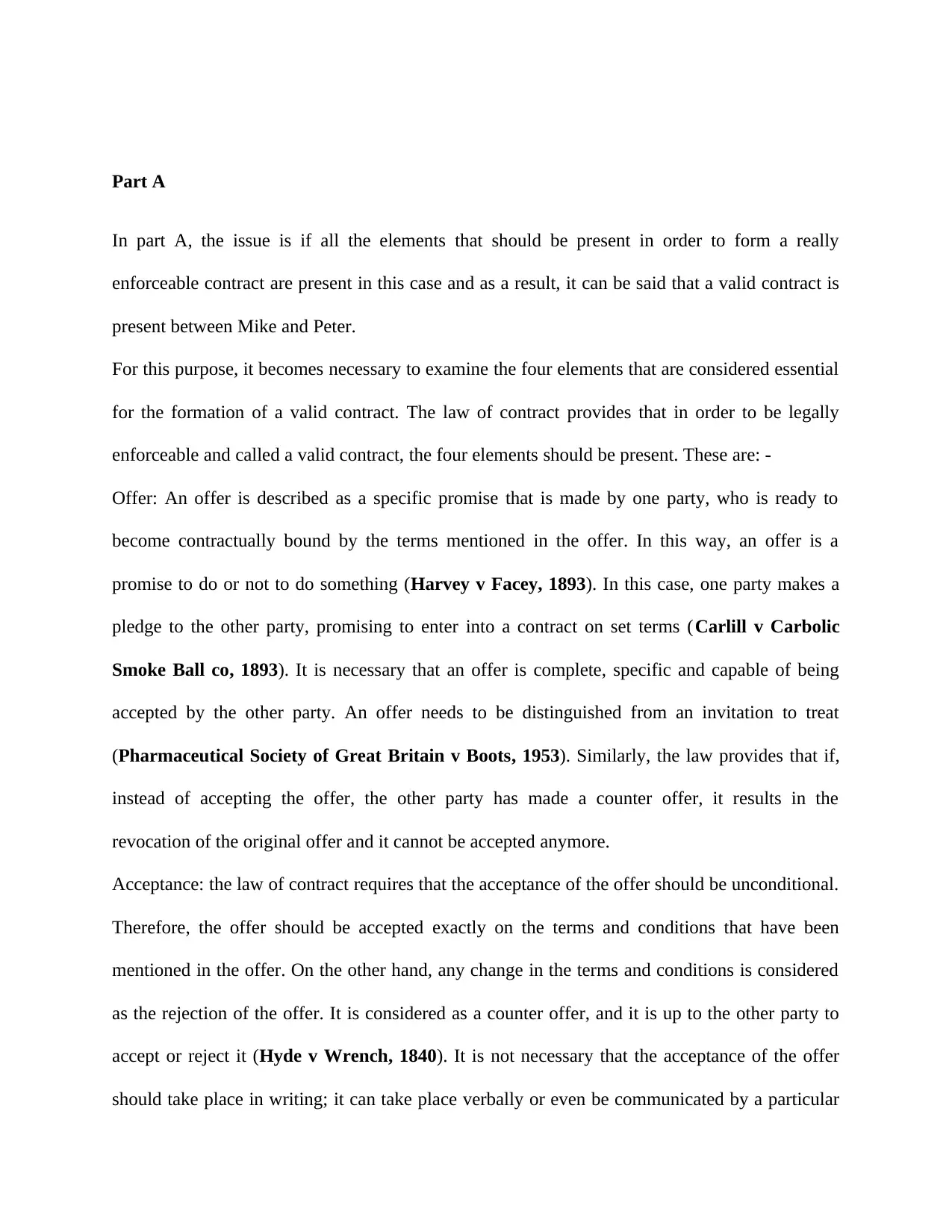
Part A
In part A, the issue is if all the elements that should be present in order to form a really
enforceable contract are present in this case and as a result, it can be said that a valid contract is
present between Mike and Peter.
For this purpose, it becomes necessary to examine the four elements that are considered essential
for the formation of a valid contract. The law of contract provides that in order to be legally
enforceable and called a valid contract, the four elements should be present. These are: -
Offer: An offer is described as a specific promise that is made by one party, who is ready to
become contractually bound by the terms mentioned in the offer. In this way, an offer is a
promise to do or not to do something (Harvey v Facey, 1893). In this case, one party makes a
pledge to the other party, promising to enter into a contract on set terms (Carlill v Carbolic
Smoke Ball co, 1893). It is necessary that an offer is complete, specific and capable of being
accepted by the other party. An offer needs to be distinguished from an invitation to treat
(Pharmaceutical Society of Great Britain v Boots, 1953). Similarly, the law provides that if,
instead of accepting the offer, the other party has made a counter offer, it results in the
revocation of the original offer and it cannot be accepted anymore.
Acceptance: the law of contract requires that the acceptance of the offer should be unconditional.
Therefore, the offer should be accepted exactly on the terms and conditions that have been
mentioned in the offer. On the other hand, any change in the terms and conditions is considered
as the rejection of the offer. It is considered as a counter offer, and it is up to the other party to
accept or reject it (Hyde v Wrench, 1840). It is not necessary that the acceptance of the offer
should take place in writing; it can take place verbally or even be communicated by a particular
In part A, the issue is if all the elements that should be present in order to form a really
enforceable contract are present in this case and as a result, it can be said that a valid contract is
present between Mike and Peter.
For this purpose, it becomes necessary to examine the four elements that are considered essential
for the formation of a valid contract. The law of contract provides that in order to be legally
enforceable and called a valid contract, the four elements should be present. These are: -
Offer: An offer is described as a specific promise that is made by one party, who is ready to
become contractually bound by the terms mentioned in the offer. In this way, an offer is a
promise to do or not to do something (Harvey v Facey, 1893). In this case, one party makes a
pledge to the other party, promising to enter into a contract on set terms (Carlill v Carbolic
Smoke Ball co, 1893). It is necessary that an offer is complete, specific and capable of being
accepted by the other party. An offer needs to be distinguished from an invitation to treat
(Pharmaceutical Society of Great Britain v Boots, 1953). Similarly, the law provides that if,
instead of accepting the offer, the other party has made a counter offer, it results in the
revocation of the original offer and it cannot be accepted anymore.
Acceptance: the law of contract requires that the acceptance of the offer should be unconditional.
Therefore, the offer should be accepted exactly on the terms and conditions that have been
mentioned in the offer. On the other hand, any change in the terms and conditions is considered
as the rejection of the offer. It is considered as a counter offer, and it is up to the other party to
accept or reject it (Hyde v Wrench, 1840). It is not necessary that the acceptance of the offer
should take place in writing; it can take place verbally or even be communicated by a particular
Paraphrase This Document
Need a fresh take? Get an instant paraphrase of this document with our AI Paraphraser
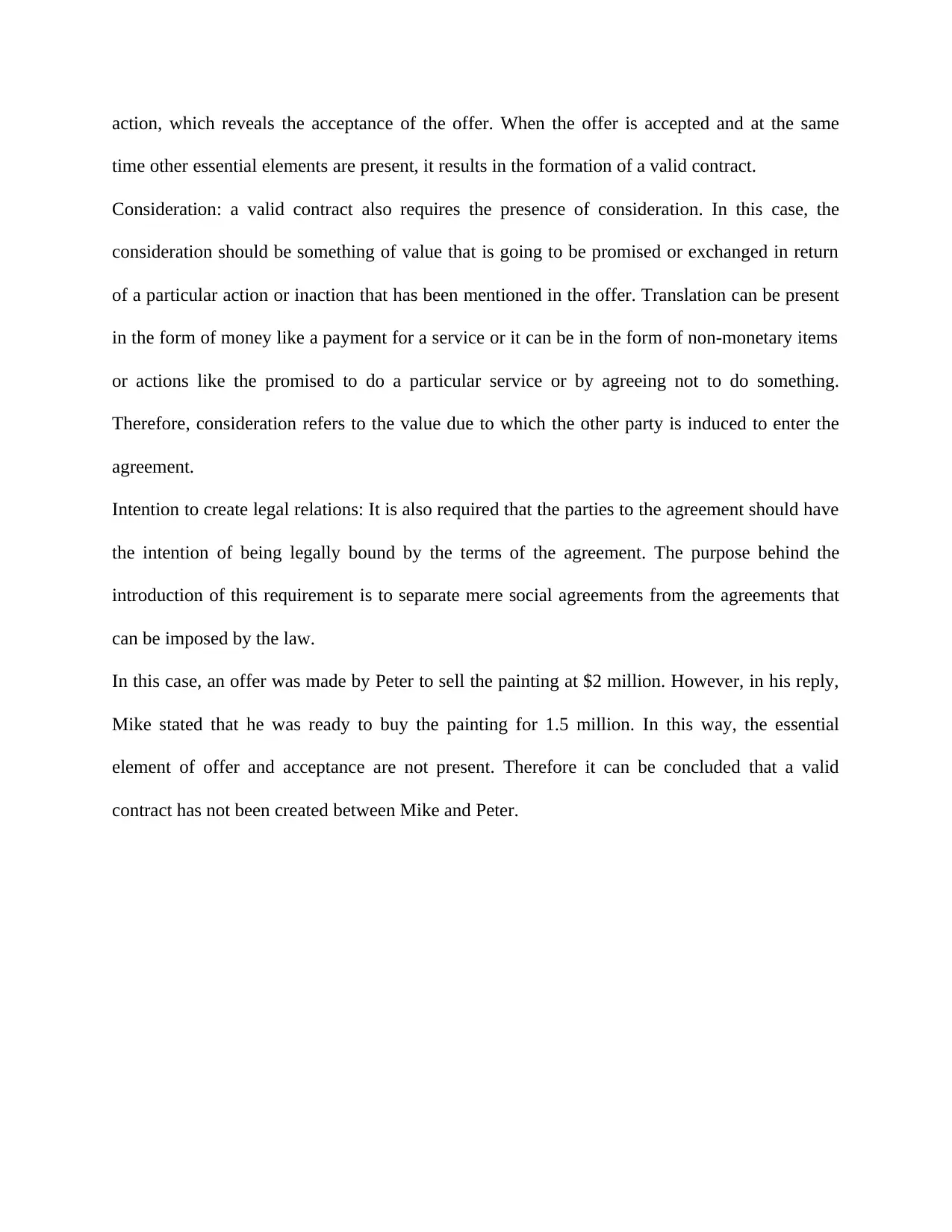
action, which reveals the acceptance of the offer. When the offer is accepted and at the same
time other essential elements are present, it results in the formation of a valid contract.
Consideration: a valid contract also requires the presence of consideration. In this case, the
consideration should be something of value that is going to be promised or exchanged in return
of a particular action or inaction that has been mentioned in the offer. Translation can be present
in the form of money like a payment for a service or it can be in the form of non-monetary items
or actions like the promised to do a particular service or by agreeing not to do something.
Therefore, consideration refers to the value due to which the other party is induced to enter the
agreement.
Intention to create legal relations: It is also required that the parties to the agreement should have
the intention of being legally bound by the terms of the agreement. The purpose behind the
introduction of this requirement is to separate mere social agreements from the agreements that
can be imposed by the law.
In this case, an offer was made by Peter to sell the painting at $2 million. However, in his reply,
Mike stated that he was ready to buy the painting for 1.5 million. In this way, the essential
element of offer and acceptance are not present. Therefore it can be concluded that a valid
contract has not been created between Mike and Peter.
time other essential elements are present, it results in the formation of a valid contract.
Consideration: a valid contract also requires the presence of consideration. In this case, the
consideration should be something of value that is going to be promised or exchanged in return
of a particular action or inaction that has been mentioned in the offer. Translation can be present
in the form of money like a payment for a service or it can be in the form of non-monetary items
or actions like the promised to do a particular service or by agreeing not to do something.
Therefore, consideration refers to the value due to which the other party is induced to enter the
agreement.
Intention to create legal relations: It is also required that the parties to the agreement should have
the intention of being legally bound by the terms of the agreement. The purpose behind the
introduction of this requirement is to separate mere social agreements from the agreements that
can be imposed by the law.
In this case, an offer was made by Peter to sell the painting at $2 million. However, in his reply,
Mike stated that he was ready to buy the painting for 1.5 million. In this way, the essential
element of offer and acceptance are not present. Therefore it can be concluded that a valid
contract has not been created between Mike and Peter.
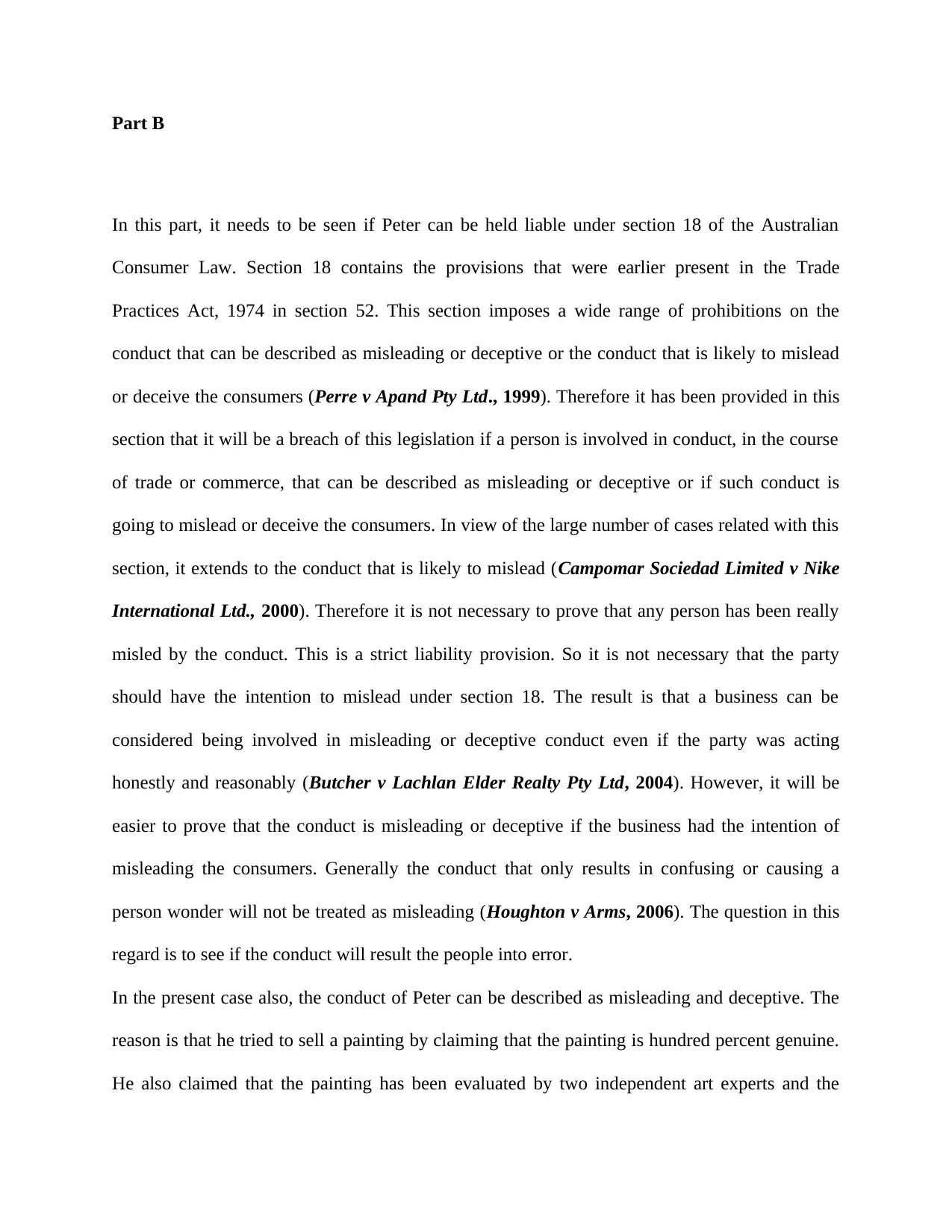
Part B
In this part, it needs to be seen if Peter can be held liable under section 18 of the Australian
Consumer Law. Section 18 contains the provisions that were earlier present in the Trade
Practices Act, 1974 in section 52. This section imposes a wide range of prohibitions on the
conduct that can be described as misleading or deceptive or the conduct that is likely to mislead
or deceive the consumers (Perre v Apand Pty Ltd., 1999). Therefore it has been provided in this
section that it will be a breach of this legislation if a person is involved in conduct, in the course
of trade or commerce, that can be described as misleading or deceptive or if such conduct is
going to mislead or deceive the consumers. In view of the large number of cases related with this
section, it extends to the conduct that is likely to mislead (Campomar Sociedad Limited v Nike
International Ltd., 2000). Therefore it is not necessary to prove that any person has been really
misled by the conduct. This is a strict liability provision. So it is not necessary that the party
should have the intention to mislead under section 18. The result is that a business can be
considered being involved in misleading or deceptive conduct even if the party was acting
honestly and reasonably (Butcher v Lachlan Elder Realty Pty Ltd, 2004). However, it will be
easier to prove that the conduct is misleading or deceptive if the business had the intention of
misleading the consumers. Generally the conduct that only results in confusing or causing a
person wonder will not be treated as misleading (Houghton v Arms, 2006). The question in this
regard is to see if the conduct will result the people into error.
In the present case also, the conduct of Peter can be described as misleading and deceptive. The
reason is that he tried to sell a painting by claiming that the painting is hundred percent genuine.
He also claimed that the painting has been evaluated by two independent art experts and the
In this part, it needs to be seen if Peter can be held liable under section 18 of the Australian
Consumer Law. Section 18 contains the provisions that were earlier present in the Trade
Practices Act, 1974 in section 52. This section imposes a wide range of prohibitions on the
conduct that can be described as misleading or deceptive or the conduct that is likely to mislead
or deceive the consumers (Perre v Apand Pty Ltd., 1999). Therefore it has been provided in this
section that it will be a breach of this legislation if a person is involved in conduct, in the course
of trade or commerce, that can be described as misleading or deceptive or if such conduct is
going to mislead or deceive the consumers. In view of the large number of cases related with this
section, it extends to the conduct that is likely to mislead (Campomar Sociedad Limited v Nike
International Ltd., 2000). Therefore it is not necessary to prove that any person has been really
misled by the conduct. This is a strict liability provision. So it is not necessary that the party
should have the intention to mislead under section 18. The result is that a business can be
considered being involved in misleading or deceptive conduct even if the party was acting
honestly and reasonably (Butcher v Lachlan Elder Realty Pty Ltd, 2004). However, it will be
easier to prove that the conduct is misleading or deceptive if the business had the intention of
misleading the consumers. Generally the conduct that only results in confusing or causing a
person wonder will not be treated as misleading (Houghton v Arms, 2006). The question in this
regard is to see if the conduct will result the people into error.
In the present case also, the conduct of Peter can be described as misleading and deceptive. The
reason is that he tried to sell a painting by claiming that the painting is hundred percent genuine.
He also claimed that the painting has been evaluated by two independent art experts and the
⊘ This is a preview!⊘
Do you want full access?
Subscribe today to unlock all pages.

Trusted by 1+ million students worldwide
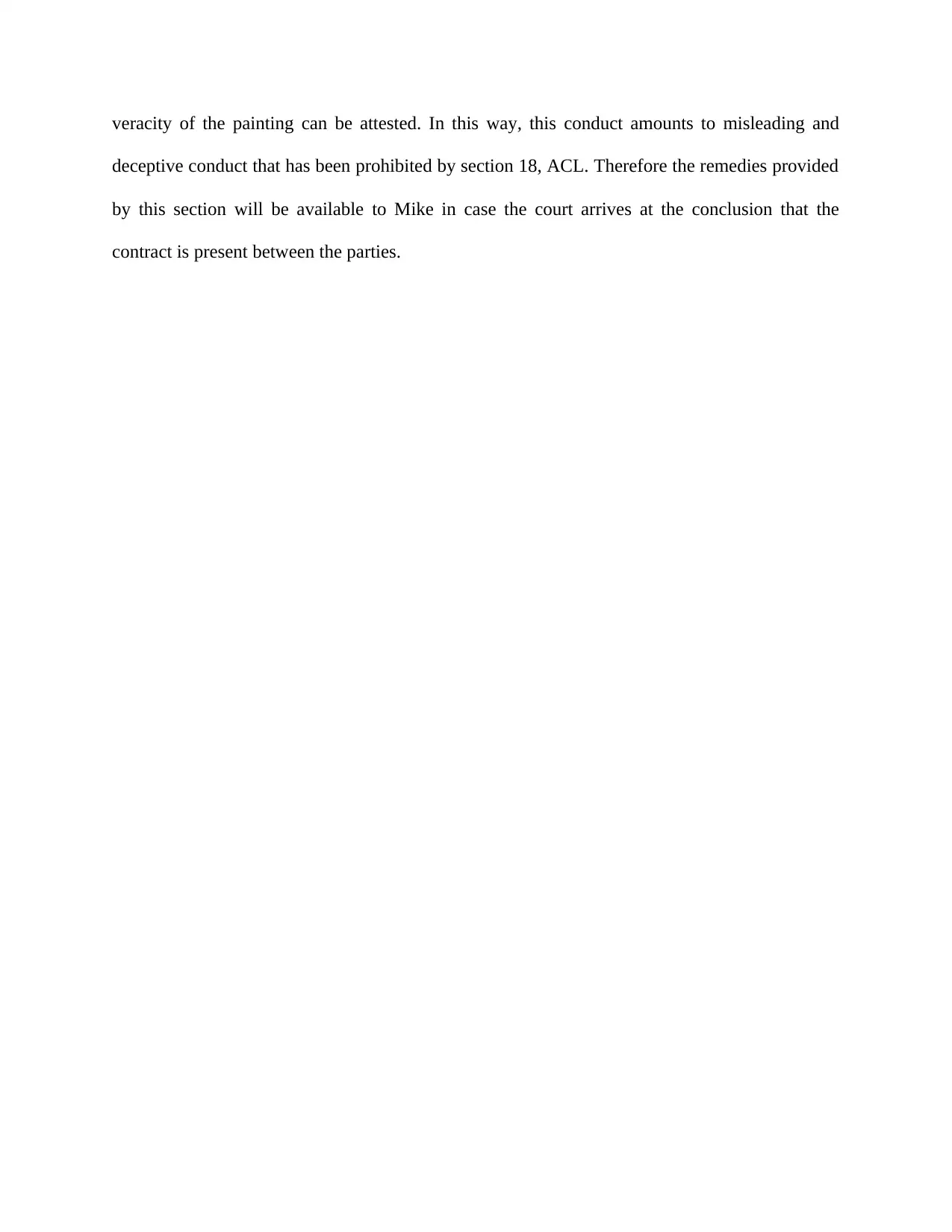
veracity of the painting can be attested. In this way, this conduct amounts to misleading and
deceptive conduct that has been prohibited by section 18, ACL. Therefore the remedies provided
by this section will be available to Mike in case the court arrives at the conclusion that the
contract is present between the parties.
deceptive conduct that has been prohibited by section 18, ACL. Therefore the remedies provided
by this section will be available to Mike in case the court arrives at the conclusion that the
contract is present between the parties.
Paraphrase This Document
Need a fresh take? Get an instant paraphrase of this document with our AI Paraphraser
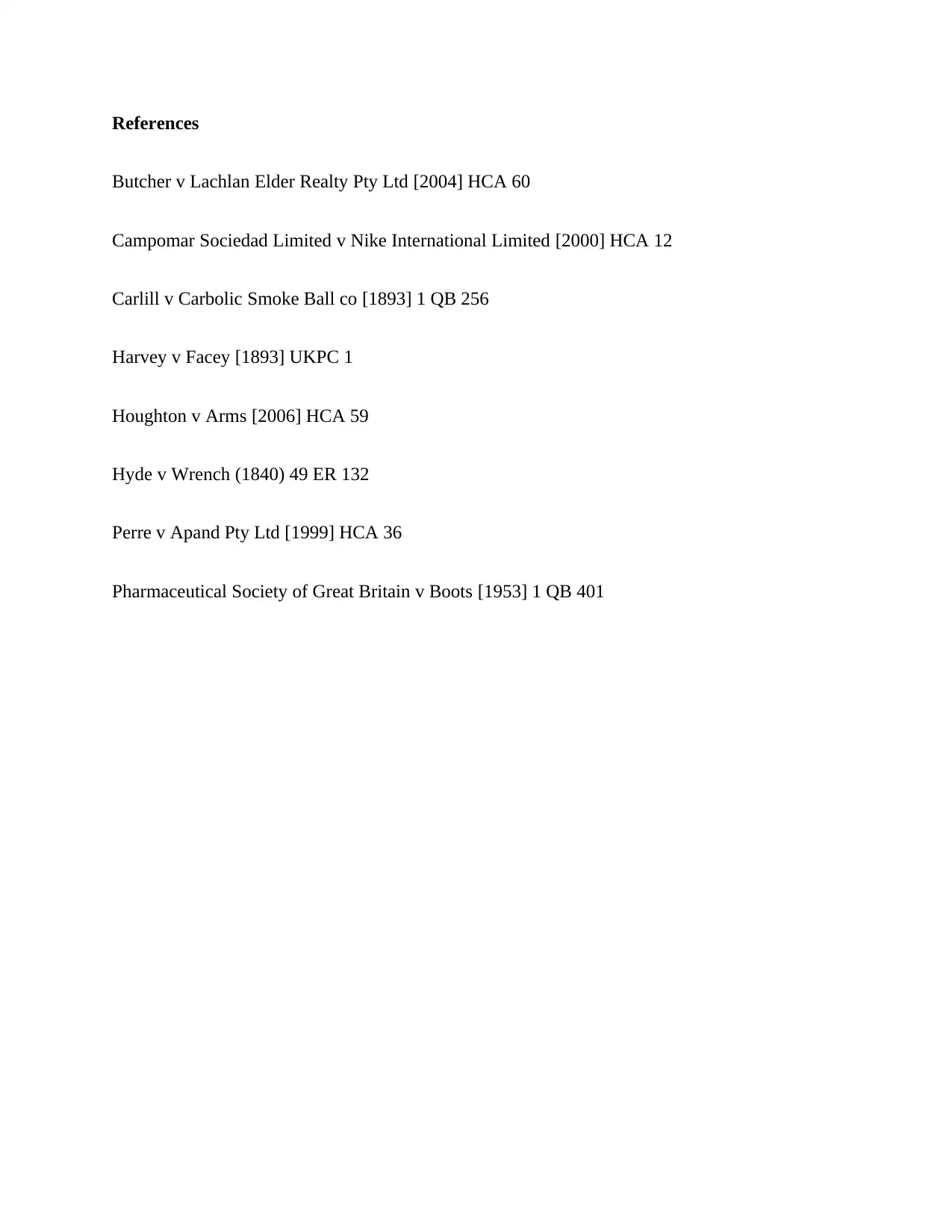
References
Butcher v Lachlan Elder Realty Pty Ltd [2004] HCA 60
Campomar Sociedad Limited v Nike International Limited [2000] HCA 12
Carlill v Carbolic Smoke Ball co [1893] 1 QB 256
Harvey v Facey [1893] UKPC 1
Houghton v Arms [2006] HCA 59
Hyde v Wrench (1840) 49 ER 132
Perre v Apand Pty Ltd [1999] HCA 36
Pharmaceutical Society of Great Britain v Boots [1953] 1 QB 401
Butcher v Lachlan Elder Realty Pty Ltd [2004] HCA 60
Campomar Sociedad Limited v Nike International Limited [2000] HCA 12
Carlill v Carbolic Smoke Ball co [1893] 1 QB 256
Harvey v Facey [1893] UKPC 1
Houghton v Arms [2006] HCA 59
Hyde v Wrench (1840) 49 ER 132
Perre v Apand Pty Ltd [1999] HCA 36
Pharmaceutical Society of Great Britain v Boots [1953] 1 QB 401
1 out of 5
Related Documents
Your All-in-One AI-Powered Toolkit for Academic Success.
+13062052269
info@desklib.com
Available 24*7 on WhatsApp / Email
![[object Object]](/_next/static/media/star-bottom.7253800d.svg)
Unlock your academic potential
Copyright © 2020–2025 A2Z Services. All Rights Reserved. Developed and managed by ZUCOL.





